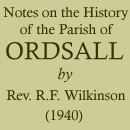< Previous | Contents | Next >
Rectories.
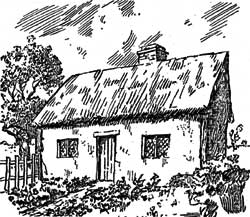
The parson's house.
The Parish of Ordsall is probably unique in the fact that within living memory there have been four separate houses for the clergy, who have been appointed to minister in the parish. There formerly was a small house in Hill Street, which leads up to the Church from the bridge. This was known to the old inhabitants as the Parson's or Curate's House. As we have already explained, from 1743 —1841, the parish was in charge of Curates, as the Rector had other appointments and lived elsewhere. We know the names of three: Rev. William Booth, 1754; Rev. John Charles worth, 1765; and Rev. Richard Morton, 1769. It is possible that they lived in this house. The Rev. Joshua Flint acted as Curate, 1769—1822, but he was also Rector of Clarborough, and lived there. In 1743, Rev. Thomas Cockshutt was appointed Rector, and he informed the Archbishop of York that he hoped to get a proper Curate, in a few weeks, to live in the parish, and he was prepared to pay £30 a year. So the Curate would not require a very large house on that income. Mr. Cockshutt himself was Vicar of Penistone, and lived there in his own residence. But the house in appearance was very old, and there seems no doubt that it was the ancient Rectory of three centuries ago. People were content to live in much smaller houses then than they are now. It was thatched and whitewashed, with four large posts at the corners, and was built of timber and bricks and plaster. It was only one storey high, with an upper room reached by a ladder, and was eventually turned into two cottages, occupied by Mr. Francis Caudle and Mr. John Tong. It was pulled down about 1870 and a new house built in the garden. The place where it stood can still be seen, where there is a gap between two houses. We hear of other parsonage houses being very small. A visitor to Tithby, in the south of the county, recorded in the year 1812, that "The Vicarage house is of clay and thatch, one storey high only, of the very worst description, consisting only of two small rooms about 5 feet 8 inches high, and very small."
We also find it recorded in the Parliamentary Survey of 1649, "There is a Vicarage at East Drayton which consisteth of a house with some few small dwelling rooms, both chambering and low rooms, with a barn and outhouses and a yard." Evidently this was a good house, but a century later, the Vicar reported "he could not live in the parsonage house, it being so extremely bad."
At the same time, the Vicar of Elkesley reported, "I do not reside in my house, it being a very mean one, let with a croft of ½ an acre at 18/-per year. And the oldest person in the parish remembers no Minister to have lived in it. There are only four poor rooms in it. The walls are studded and daubed with clay."
About 1740, the Vicarage at East Retford was "entirely in ruins." At that time a Curate, Rev. J. Sampson, did duty at East and West Retford, for which he received £35 a year! He lodged in the town. The Vicar and Rector both lived in York. In 1710, the Rector of Gotham found that he had the largest house in the Diocese.—"I have 120 windows, in the dwelling house, 8 staircases and not one good one. and 100 doors, made of sawn boards, on the premises."
These instances give us some idea of the very simple way in which the poorer clergy lived in past days. We give an illustration of the former house at Ordsall, as the old inhabitants remembered it seventy years ago.
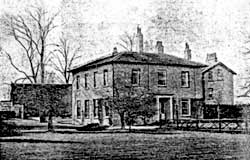
Ordsall House.
In the year 1812, Rev. Francis Foxlowe was appointed Rector of Ordsall. He came from an old Derbyshire family, and his father was the owner of Staveley Hall. He was also Vicar of Elmton, and chose to reside in the Vicarage there, and place a Curate in charge of Ordsall. The Rev. J. Flint, Vicar of Clarborough, acted as Curate, and came over to take the services every Sunday until he died in 1822. The Rev. T. H. Marshall, of Lindrick House, Tickhill, then he came Curate-in-Charge of Ordsall. He was Curate for eight years (1822-1830), and a new Rectory, in the Georgian style of that period, was built for him close to the Church. The house was evidently completed sometime before 1828, for Piercy published his "History of Retford " in this year, and records that "The Rectory House is very spacious, and, from its choice situation, is calculated to afford a comfortable residence for those appointed to minister to the spiritual wants of the parishioners." Presumably the house was built at the expense of the Rev. F. Foxlowe. A Curate's stipend then was only £60 a year, but the Rev. T. H. Marshall was evidently not dependent on this alone, as he was also Vicar of Pontefract. The Rev. William Bury married Julia Marshall, daughter of the above, and succeeded his father-in-law as Curate in 1830. They were married by licence in Ordsall Church on April 23rd, 1829, and the entry in the register describes Mr. Bury as "Clerk of the parish of Longstone, Cambridgeshire." Mrs. Bury returned to her old home a year later, and remained until 1832, when her husband was appointed Vicar of Ratcliffe, near Nottingham. Two sons were born, while they lived at the Rectory, and both were christened by their father in Ordsall Church: Thomas William Bury on September 4th, 1831, and Percival Bury on July 29th, 1832. The Rev. C. Bigsby (1832-1836), Rev. J. Rhodes (1836-1838), and Rev. F. O. Morris (1838-1841) all lived in this house as Curates of Ordsall. The last-named was the famous authority on British Birds and Eggs, and it is said that the large beech trees, which are such an ornament to the gardens, were planted in his time. The first Rector who lived here was the Rev. Thomas King (1841-1873). The Rev. S. K. Stothert succeeded him (1873-1896) and the last Rector to live in the house was Rev. S. W. Stott (1896-1907). He considerably enlarged the house and grounds as soon as he came. Afterwards it was occupied by Mrs. Stott for some years, and then it was let to Dr. Walker. In 1920 it was sold with the two fields adjoining it, to Mr. H. J. Wigram, who lived there until 1924. In that year it was purchased by the late Mr. C. F. Darley, of Thome, who eventually went to live at Ranby Hall in 1929. A few months later it became the property of Mr. H. A. Longbotham, who had previously lived at Langwith Lodge. Since that time he and Mrs. Longbotham have made it their home. After it ceased to be the Rectory, it became known as "Ordsall House.''
If John Piercy could come back, he would find that the House is still very spacious (in its hospitality) and from its choice situation (for Garden Fetes) it ministers very often to the wants of the parishioners.
In its ideal situation next the Church, there is an old-world charm about the house and gardens, such as is often found among the houses of the country clergy, reminding us of a more spacious and leisured age in our Church life, that has now passed away.
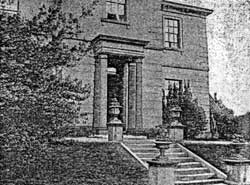
Holly Mount (Rectory No. 3).
For fourteen years (1908 -1922) a house on the London Road, known as Holly Mount, was used as the Rectory by the Rev. R. D. Foster. It also has some history. About 1870 it was occupied by Mrs. Savile Lumley, mother of the late Lord Savile, of Rufford Abbey. She lived here with her son and two daughters. Other residents include Messrs. Geo. Marshall, Clark, & Jenkinson. Mrs. Mudford lived here on two occasions. The Rev. W. J. Sparrow lived here while the old Vicarage was being built for him at Gamston. Mr. Gillatt, of Sheffield, also owned it for a time. In 1908, the house was purchased as a home for the Rev. R. D. Foster, who had recently married the daughter of Mrs. Stott. They continued to live here after he became Rector, until his resignation in 1922. The house was then sold and was used as a nursing home for a time. It is now the Conservative Club.
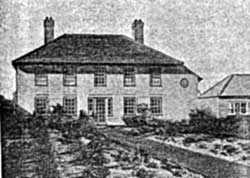
The Rectory (No. 4).
The present Rectory was built in 1925 by Rev. M. G. James, Sector (1923-1926) with the money (£2,000) from the sale of the old Rectory, but he never lived in it. The house cost £1,750, and the land £250. Like its big neighbour, erected a hundred years before, it was also meant to be "in the Georgian Style," and its somewhat novel appearance with twenty four windows, created much discussion at the time. It stands in an acre of ground, which was part of the large arable field next the Churchyard. It has been occupied since 1925 by the Rector, Rev. R. F. Wilkinson, which fact is at present its sole title to historic fame!
